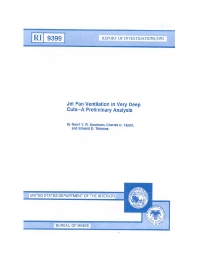 |
Future coal mining systems will be able to cut from crosscut to crosscut where advances could exceed 100 ft. However, limitations arise when ventilating such mining systems. In deep advance mining, there would be no workers at the face to advance ventilation tubing or curtain manually. Traditional methods also provide no means for maintaining face ventilation after the miner backs away from the face. U.S. Bureau of Mines research is studying means to provide effective ventilation at cut depths beyond the current limit of 40 ft. Several innovative ventilation schemes are currently being considered. One such method is the use of a jet fan to ventilate a deep cut. A jet fan is simply a freestanding fan using little or no ducting to direct the ventilation flow. Jet fan testing in a 90-ft entry revealed that higher exit velocities and greater penetration depth occurred when various configurations were used to confine and direct the air flow. Additional testing also indicated that 2,200 cfm of fresh air was delivered to the face 90 ft distant when a check curtain was used to limit entrainment around the fan. Without this curtain, this quantity dropped to only 1,000 cfm. This testing indicated that a jet fan was capable of providing ventilation to a distant face area. It also highlighted potential problems, such as recirculation at the fan and reentrainment in the jet flow. Despite these potential problems, jet fans may be adequate for ventilating cuts exceeding 40 ft.
| Author(s): | Goodman-GV, Taylor-CD, Thimons-ED |
| Reference: | U.S. Department of the Interior, Bureau of Mines, Report of Investigations 9399, 1992:1-12 |
ri9399 (PDF, 1756 KB)
